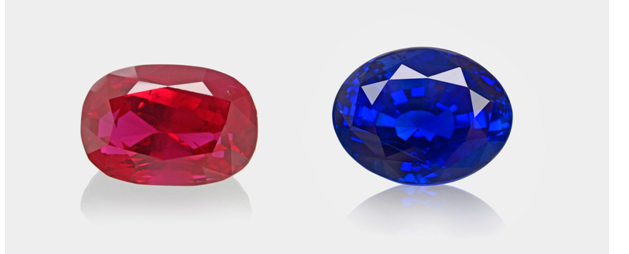News
The Swiss-based Gübelin Gem Lab and Swiss Gemmological Institute SSEF, recognised as the leading laboratories for coloured stone testing, have agreed to harmonise their standards for the colour terms “pigeon blood red” and “royal blue.” Their goal is to standardise the usage of these terms for the benefit of the international gemstone trade.
 The colour terms “pigeon blood red“ and “royal blue“ have been used for centuries by the trade to describe, respectively, only the finest quality rubies and sapphires, which aside from their distinct colours, invariably are stones of superior quality, and hence are among the most coveted gems.
The colour terms “pigeon blood red“ and “royal blue“ have been used for centuries by the trade to describe, respectively, only the finest quality rubies and sapphires, which aside from their distinct colours, invariably are stones of superior quality, and hence are among the most coveted gems.
But, while commonly understood to refer to fine quality stones of specific hues of saturated red and blue, until now there never has been definite agreement as to the precise colours and quality criteria that correspond to the two terms.
Nonetheless, due to increased demand from the trade for more independent assessments, gemmological laboratories have of late begun to use these colour terms on their reports. But in the absence of an international standard, the use of both terms on lab reports tends not only to be inflationary, but frequently ambiguous. This trend is contradicting the terms' historical connotation.
Initially, SSEF and Gübelin independently developed their own strict criteria which rubies and sapphires qualify for these colour terms. Now, with the intention to bring clarity to the industry, the two labs mutually compared their criteria, and found them to largely coincide. A few minor changes were agreed upon to further harmonise the standards the two labs apply. Based both on colour and quality, they are detailed below.
SSEF & Gübelin standard for “pigeon blood red” rubies and “royal blue” sapphires:
1) Colour criteria:
For a ruby or sapphire to qualify for the term “pigeon blood red” or “royal blue”, respectively, the colour has to be an intense, saturated and homogeneous red or blue. The exact ranges of hue, saturation and tone are defined by sets of masterstones. A comparison of the independently created sets held by both laboratories, Gübelin and SSEF, has shown that they are very consistent.
“Pigeon blood red” is best described as a red colour, with no apparent colour modifiers (such as blue or brown). A minute purplish tint is acceptable. The body colour of pigeon blood red rubies is complemented by a strong fluorescence when exposed to ultraviolet light. This fluorescence is caused by high chromium content combined with low iron content, and results in the distinct "inner glow" coveted by ruby connoisseurs.
Historically, the term “pigeon blood red” was introduced for rubies which formed in marbles of the Mogok Gemstone Tract in Burma (Myanmar), and which are characterised by a very low iron concentration. With the discovery of additional ruby deposits in marbles in Burma, such as at Mong Hsu, and in other countries, this term is no longer restricted to rubies from the Mogok region. Nonetheless, most rubies from places other than Burma contain higher concentrations of iron that suppress fluorescence, and consequently do not comply with the labs’ criteria.
“Royal blue” is best described as a saturated blue colour, either pure or with a very slight purplish tint. While “royal blue” is a term that was historically coined for the best quality of sapphires originating from the Mogok area in Burma, sapphires from other metamorphic deposits, such as those found in Madagascar and Sri Lanka, may also display the properties required to qualify for the “royal blue” term.
2) Quality criteria:
In terms of quality, these colour terms can only be applied to rubies and sapphires that exhibit fine qualities, and have not undergone any modification of colour and/or clarity.
Any type of treatment (such as heating, fissure filling, etc.) disqualifies them from being described using these colour terms. Furthermore, they must be relatively free of eye-visible or dark inclusions, and they must show a homogeneous colour distribution with vivid internal reflections.
The size of the stones is not considered a criterion, meaning that small rubies and sapphires may qualify for these colour terms.
The goal: A harmonised standard to protect the trade
Gübelin and SSEF have agreed to harmonise their definitions and testing procedures for “pigeon blood red” and “royal blue”. The equally strict and well-defined criteria are based on decades of experience and research. With this harmonisation, the two labs intend to foster a responsible and meaningful application of these terms in the trade.
"By applying these harmonised standards, it is the aim of SSEF and Gübelin Gem Lab to provide the trade with unified and consistent guidelines for the use of these historically significant terms," said Dr. Michael Krzemnicki, Director of SSEF.
"Clearly, such stringent sets of criteria implies that only a very small percentage of rubies and sapphires qualify” stated Dr. Daniel Nyfeler, Managing Director of the Gübelin Gem Lab. "This is in line with the experience and belief of both Gübelin and SSEF that historically only exceptional rubies and sapphires were attributed these quality terms."
More detailed information about the criteria for “pigeon blood red” and “royal blue” are found on the websites of:
For further information, please contact:
Dr. Michael S. Krzemnicki
Director, SSEF
Dr. Daniel Nyfeler
Managing Director, Gübelin Gem Lab
